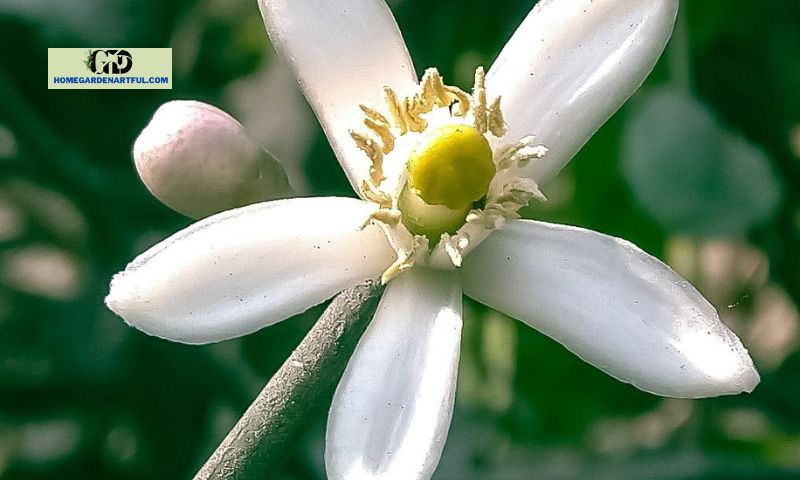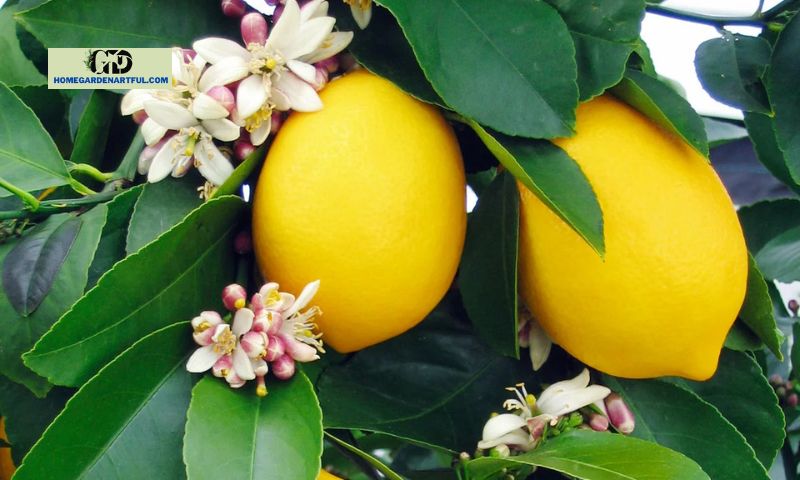Unlock the secrets of lemon tree flowers and their vital role in pollination and fruit formation. Discover how healthy blooms ensure a fruitful harvest.
Lemons, with their zesty flavor and refreshing aroma, have long been a staple in kitchens and gardens alike. But have you ever stopped to appreciate the delicate beauty of lemon tree flowers? These vibrant blossoms not only captivate the senses but also play a vital role in the overall growth and health of lemon trees. In this article, homegardenartful.com will delve into the enchanting world of lemon tree flowers, exploring their anatomy, significance, and the factors that influence their flourishing presence.
Lemon tree flowers, with their soft petals and citrusy fragrance, are the precious precursors to the luscious fruits we crave. They serve as nature’s matchmakers, facilitating the pollination process and ensuring the propagation of new lemon trees. Each blossom holds the promise of a bountiful harvest, making it an essential element in cultivating a thriving lemon tree.
But why are lemon tree flowers so crucial? Well, it all comes down to fruit production. Without healthy and abundant flowers, the chances of a fruitful lemon tree harvest are greatly diminished. These blossoms are responsible for attracting pollinators such as bees and butterflies, who dutifully transfer pollen from flower to flower, enabling fertilization and the subsequent formation of lemons. In essence, lemon tree flowers are the catalysts of nature’s cycle, orchestrating the creation of the tangy treasures we adore.
As a gardener or enthusiast, understanding the intricacies of lemon tree flowers is paramount to ensure their optimal growth and development. Factors such as temperature, sunlight, humidity, and soil fertility all play a part in determining the abundance and health of these delicate blooms. By providing the right conditions and implementing proper care practices, you can encourage your lemon tree to burst forth with an exuberant display of flowers, enhancing the chances of a fruitful harvest.
Join me on this captivating journey as we unravel the secrets of lemon tree flowers. Together, we’ll explore the various aspects that influence their growth, tackle common issues and diseases, and discover effective techniques to promote abundant flowering. Get ready to immerse yourself in the world of lemon tree flowers, where beauty meets functionality and nature’s artistry unfolds before our eyes.
Understanding Lemon Tree Flowers

Anatomy and Characteristics of Lemon Tree Flowers
Lemon tree flowers, like delicate works of art, possess a unique anatomy that contributes to their allure. These flowers are typically small and white, consisting of five petals that spread open to reveal a cluster of vibrant yellow stamens at their center. The petals exude a gentle, citrusy fragrance, enticing pollinators to embark on their vital mission. Understanding the intricacies of lemon tree flower anatomy allows us to appreciate the beauty and significance they hold.
The Role of Lemon Tree Flowers in Pollination and Fruit Formation
Lemon tree flowers, aside from their aesthetic appeal, play a pivotal role in the pollination process and the subsequent formation of fruits. As pollinators, such as bees and butterflies, visit the flowers in search of nectar, they inadvertently transfer pollen from the male stamens to the female stigma, triggering fertilization. This process ensures that the lemon tree can produce the seeds necessary for fruit development.
The union of pollen and stigma sets in motion a remarkable transformation. The fertilized flower begins to develop a tiny fruit, known as the ovary, which gradually expands to become the lemon we know and love. It is through the intricate dance between lemon tree flowers and their pollinators that the cycle of life continues, resulting in the creation of abundant, succulent lemons.
The Significance of Healthy Flowers for a Successful Lemon Tree Harvest
For a lemon tree harvest to be truly fruitful, the presence of healthy and abundant flowers is paramount. Healthy flowers not only attract pollinators but also ensure successful fertilization and subsequent fruit formation. Without an ample number of flowers, the potential for a bountiful harvest diminishes significantly.
Moreover, healthy flowers indicate the overall well-being of the lemon tree. They serve as indicators of the tree’s vigor, reflecting proper care, nutrition, and environmental conditions. By nurturing and promoting the growth of healthy flowers, you are not only enhancing the productivity of your lemon tree but also safeguarding its long-term health and vitality. So, let us explore the factors that influence the flowering of lemon trees, ensuring the abundance of these precious blossoms.
Common Issues and Diseases Affecting Lemon Tree Flowers

Identifying Common Problems
Lemon tree flowers, though resilient, are not immune to various issues that can hinder their growth and vitality. It’s essential to be aware of these common problems to promptly address them and safeguard the health of your lemon tree’s blossoms.
1. Fungal Infections
Fungal infections pose a significant threat to lemon tree flowers. The most prevalent fungal diseases include powdery mildew, citrus scab, and sooty mold. Powdery mildew manifests as a white powdery coating on the leaves and flowers, while citrus scab results in raised, scaly lesions. Sooty mold, on the other hand, appears as a black, velvety layer caused by honeydew secretions from pests like aphids or scales.
2. Pests
Lemon tree flowers can fall victim to various pests, including aphids, scales, and citrus leaf miners. Aphids are tiny insects that suck sap from the flowers, causing deformities and stunted growth. Scales, on the other hand, appear as small, immobile bumps on the flowers, feeding on plant sap. Citrus leaf miners lay eggs on the leaves, and their larvae tunnel through the leaves, hindering the overall health of the tree.
3. Nutrient Deficiencies
Nutrient deficiencies can impact the vigor and productivity of lemon tree flowers. Common deficiencies include nitrogen, phosphorus, potassium, and iron. Nitrogen deficiency leads to pale yellow leaves, reduced flower production, and stunted growth. Insufficient phosphorus results in dark green leaves, reduced flowering, and poor fruit development. Potassium deficiency causes yellowing leaves and weak flower formation. Lastly, iron deficiency causes yellowing of the leaves with green veins, known as chlorosis.
Prevention and Management Strategies
To ensure healthy flower growth and protect your lemon tree from these issues, it is crucial to implement preventive measures and effective management strategies. Here are some tips to help you maintain thriving lemon tree flowers:
1. Proper Sanitation
Regularly remove fallen leaves and debris from the base of the tree to minimize the risk of fungal infections. Prune any infected branches or flowers to prevent the spread of diseases.
2. Natural Predators and Beneficial Insects
Encourage the presence of natural predators and beneficial insects in your garden, such as ladybugs and lacewings, to control aphids and scales.
3. Adequate Watering and Fertilization
Provide your lemon tree with sufficient water and balanced fertilization to ensure the availability of essential nutrients. Conduct soil tests to identify any deficiencies and address them accordingly.
4. Organic Pest Control
Consider using organic pest control methods such as neem oil or insecticidal soaps to manage pests while minimizing harm to beneficial insects and the environment.
By being vigilant and proactive in addressing these issues, you can safeguard the health and beauty of your lemon tree flowers. Remember, healthy blossoms are the gateway to a bountiful lemon tree harvest.
Promoting Flowering in Lemon Trees

Stimulating and Enhancing Flowering
Are you eager to witness a profusion of lemon tree flowers adorning your garden? With a little know-how and some expert tips, you can encourage your lemon trees to burst forth with an abundance of blossoms. Let’s explore practical advice to stimulate and enhance flowering, turning your lemon tree into a captivating spectacle.
The Role of Watering, Fertilization, and Overall Tree Health
Watering and fertilization practices play a crucial role in promoting abundant flower production in lemon trees. Proper hydration is essential, as both under and overwatering can hinder flower formation. Strike the right balance by watering your lemon tree deeply and consistently, ensuring the soil remains moist but not waterlogged.
Fertilization is another key factor in encouraging healthy flower growth. Provide your lemon tree with a balanced fertilizer specifically formulated for citrus trees. High-quality fertilizers should contain a blend of essential nutrients, including nitrogen, phosphorus, and potassium, which are vital for robust flower development. Apply the fertilizer according to the manufacturer’s instructions, taking care not to overdo it as excessive nutrients can lead to imbalances and hinder flowering.
Maintaining overall tree health is equally important. Regular pruning helps remove dead or diseased branches, allowing sunlight to reach all parts of the tree, including the flowers. Pruning also helps improve air circulation, reducing the risk of fungal infections that can harm flower production. Keep an eye out for any signs of pests or diseases, and promptly address them to prevent damage to the flowers and overall tree health.
Organic Fertilizers and Natural Remedies to Boost Flowering
For those inclined towards organic gardening, there are alternative methods to stimulate flowering in lemon trees. Organic fertilizers, such as compost or well-rotted manure, can provide essential nutrients while improving soil structure and fertility. These natural amendments gradually release nutrients, promoting long-term flower production.
Additionally, natural remedies like foliar sprays made from seaweed extracts or compost tea can be beneficial in boosting flower development. These organic solutions provide a dose of micronutrients and growth-promoting compounds that can invigorate your lemon tree’s flowering capabilities.
By implementing these practical strategies and considering organic alternatives, you can unlock the full potential of your lemon tree’s flowering prowess. Witness the transformation as your tree becomes a veritable floral masterpiece, enchanting both you and your garden visitors with its abundant and vibrant blossoms.
Conclusion
In the fragrant realm of lemon tree flowers, we have uncovered the secrets that make these delicate blossoms the guardians of a bountiful lemon harvest. From their enchanting beauty to their vital role in the pollination process, lemon tree flowers are much more than mere adornments in a garden. They serve as nature’s architects, orchestrating the creation of the tangy treasures we savor.
By understanding the anatomy and characteristics of lemon tree flowers, we gain insights into the intricate workings of nature’s design. We have explored the significance of these blossoms in the pollination process, recognizing their role as matchmakers for bees and butterflies. Without healthy and abundant flowers, the chances of a successful lemon tree harvest are greatly diminished.
To cultivate a flourishing lemon tree, we must pay heed to the needs of its flowers. Factors such as temperature, sunlight, humidity, and soil fertility all influence the growth and abundance of lemon tree flowers. By creating the optimal environment and implementing proper care practices, we can enhance the chances of a vibrant floral display and a fruitful harvest.
In the world of lemon tree flowers, beauty intertwines with functionality. Their ethereal presence not only adds charm to our gardens but also ensures the continuation of lemon tree generations. So, let us embrace the fragrant essence of lemon tree flowers, appreciating their significance and marveling at the wonders they bring forth.
As you embark on your journey of cultivating lemon trees, remember to nurture the delicate blooms that hold the promise of future harvests. With the knowledge you have gained, may your lemon tree flourish with abundant flowers, bringing joy to your garden and the tantalizing taste of lemons to your table.
homegardenArtful.com – where nature’s artistry and fruitful harvests intertwine.


